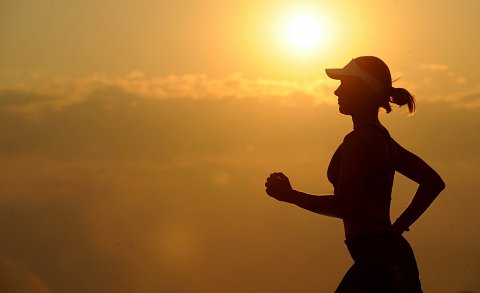-
Pillcheck
review on 12 April 2017
by Craig Macpherson

At a Glance
Summary
In summary, I’m really glad I took the Pillcheck test. I was particularly impressed that it was so useful to someone not currently taking any medications and felt that it would be a really useful tool for my doctor when prescribing anything in the future.
I did find that some phrases were a little complex and made parts of the report a little difficult to understand. This said, I was clearly able to see which of the medications I should be wary about using, which was the main thing I expected to get from the results, and the rest will hopefully be useful to my doctor.
I’d recommend this test even to those that don’t take any current medications. It was interesting to read, and I felt that it was likely to be a valuable tool for helping me stay as healthy as possible, both now and in the future.
Full Review
Pillcheck is a service offered by the Canadian company, GeneYouIn. Their team includes several PhD advisors and project managers, and specialises in personalised medicine, specifically optimisation of medication regimens through pharmacogenomics. Founded in 2012, the company offers the Pillcheck test to customers both through clinicians as well as directly.
Product expectations
The product itself is one of only a few DNA tests that solely focus on predicting your response to certain drugs, based on genetic variants in your DNA. There was lots of information about it on the website. I had the option to search for medications that I was interested in finding out about, but also had the choice to see a full list of those that were included in the test. I learned that the test covered over 100 medications and these were sorted into 19 categories, which made them easier to look through in the full list.
There was a ‘How it works’ section, which explained that I’d take my sample using a cheek swab, and that I’d receive my results via my online account around 10-15 days after my sample arrived back at the lab. Meeting with my doctor to discuss my results was also emphasised as an important part of the process. I was impressed to read that a number of organisations, including the European Medicines Agency (EMA), had recommended the test. This set of questions also included a more detailed description about how the process would work and informed me that my sample would be destroyed 30 days after I received my results.
The terms and conditions were quite standard and simple to read through, though there was a repeated emphasis that the results should not be acted on without first consulting a doctor.
Ordering experience
Before ordering the test, I had to complete a consent form. This made clear that the test wouldn’t analyse my DNA to give any details about any conditions I might suffer from, just the medications and doses that I would likely react best to. I was pleased to see that I could request for both my genetic and medication information to be deleted after taking the test. This would include removal of both data from my report and any they included in their ‘clinical research database’. I was also relieved to see that they wouldn’t share any of my information with insurance companies or employers. It was, however, disappointing to read that, by agreeing to the consent form, I would be allowing GeneYouIn to pass on data to research companies (anonymously) without compensating me, even if it helped to lead to any discoveries.
Once I had completed the consent section, ordering was simple. I provided my name, email and address for the kit to be sent to and paid with my credit card. Shipping was more expensive than I was expecting, at CAD$58 (about £35/$45), and I wished they had made this clearer earlier on in the process. However, the FedEx tracking was very thorough and I received my kit in two working days after I’d placed my order. It was even quicker on the way back (though I had to pay another £5 to drop it at a FedEx collection point), and my samples arrived at the lab only a day after they’d been picked up.
Results section
I received an email notification that my results were ready just over a week later. I was able to access them via the Pillcheck portal, which I’d set up an account with when activating my kit. Upon setting up the account, I had the option to include details about any current medical conditions I was suffering from and any medications I was taking. I’m healthy and don’t take any medications, so checked the ‘none’ tick box.
Once I’d received the email informing me that my results were ready, I logged in and had the option to view the ‘Report’ or the ‘Pharmacist Opinion’ documents. The report itself was split into three main sections: ‘Guide to Using This Report’, ‘Summary of Your Test’ and a more detailed look at each medication tested for.
Results section: Guide to using the report
The first section of the report, which was viewed in a PDF, was a guide to the using the report (shown below).

A section of my Guide to Using This Report.
This included a ‘Meaning of Drug Tags in Table of Contents’ key, a disclaimer that included similar information to the consent form, and a section with the heading ‘Technology’. This detailed all of the genes that were analysed, and which alleles were tested. I would have found this more useful if there were an accompanying explanation, as I wasn’t quite sure what an allele was. After a quick internet search I realised that alleles are just versions of the gene, and that different people have different ones. This section also included details about the equipment that was used to analyse my DNA (not shown in the screenshot) and the limitations of the test. Despite not quite understanding all of it, I was impressed that this information was included in the report.
Next, there was a summary of the results of the test. A section of this is shown below.
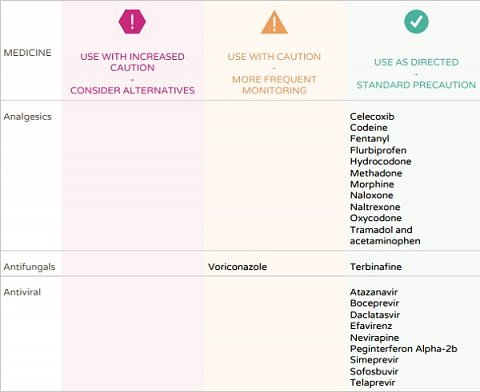
Part of my Summary of Your Test table.
This used the symbols that were included in the key at the beginning. Usefully, each symbol was accompanied with a description of its meaning anyway, so I didn’t find myself needing to refer back to the key. The medications were sorted into different categories, some of which were quite straightforward to understand (eg. antivirals treat viral infections, antifungals treat fungal infections) but there were others that I wasn’t so sure about (eg. analgesics).
I was reassured to find that all but a few of the medications included in the test were in the green category, meaning that I was most likely to metabolise and respond to them in a normal way. It was really good to have this summary of results as I could then go on to look at those that I should use with caution.
These included drugs that I should use with caution because of a reduced metabolism (Voriconazole, Irbesartan, Losartan, Carisoprodol, Caffeine, Clobazam, Lacosamide, Diazepam, Olanzapine) and one which I should use with increased caution because of a substantially reduced metabolism (Clopidogrel). I hadn’t heard of many of these, but was particularly interested in my caffeine result, as I regularly drink four or more shots of coffee a day.
Results section: Detailed results
Because I was most interested in my caffeine result, I decided to look at this in detail first. As I scrolled down, I came across a contents page (shown below).
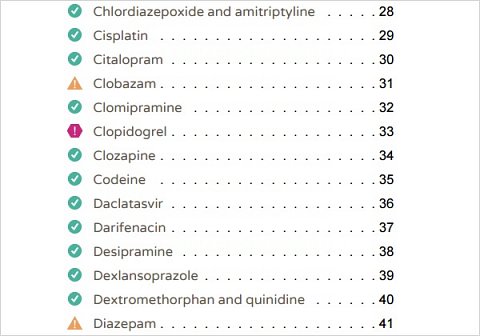
A part of the contents page.
This list of contents usefully included an alphabetical list of all the drugs included, each accompanied by a symbol indicating what type of result it was. I quickly found my caffeine result, though it would have helped to have had a hyperlink from the contents to the page listed. My detailed caffeine result is shown below
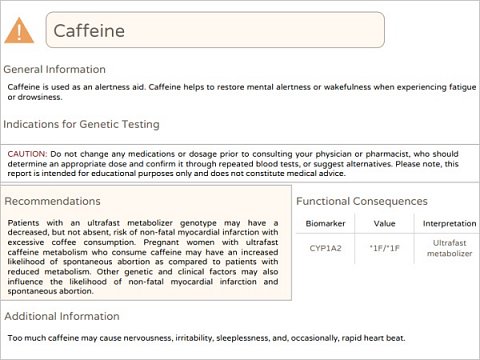
My detailed caffeine result.
This section included a lot more detail that the initial summary. There was quite a lot of text, but the table that included which biomarker had been used, accompanied by ‘Value’ and ’Interpretation’ columns, broke it up a little. I wasn’t sure what the ‘Value’ column meant, but it was useful to see immediately that I was an ‘ultrafast metabolizer’ of caffeine, according to the gene that was analysed.
My assumption was that this meant I should reduce my intake, as I would react more quickly to it. However, when I read the ‘Recommendations’ section, I realised that this actually meant I was less likely than average to have a ‘non-fatal myocardial infarction’ (I learnt from a Google search that this basically means a heart attack that doesn’t kill you). I was relieved to find out that I wouldn’t have to give up my daily coffees, but was slightly confused about why this had been flagged up as something that should be taken with caution.
Each detailed result was accompanied by at least one link to a supporting scientific study, which impressed me. I also appreciated the ‘general information’ at the top and the ‘Additional Information’ at the bottom, especially for the more obscure results. The first of these was the only one of my results that had showed as red (meaning I should take it with increased caution), Clopidogrel. The result explained that it was a medicine used for those who had suffered from a heart attack or stroke, to prevent the formation of blood clots. I also learnt that this was one of the most commonly prescribed drugs for this purpose. As high blood pressure and heart problems are something my relatives have suffered from (albeit at an old age) I found this result particularly useful.
The recommendations for my Clopidogrel result were more specific than for my caffeine one, and were definitely aimed more at my doctor than me. I didn’t mind this and felt confident that if I gave this to a medical professional there would be enough information for them to prescribe the drug that I would best react to. I was also impressed that there wasn’t just one, but several different alternative treatments recommended, for different types of patients (eg. those of different ages or medical histories)
Results Section: Pharmacist Opinion
Once I had looked through the rest of my reports I moved on to the pharmacist letter (shown below).
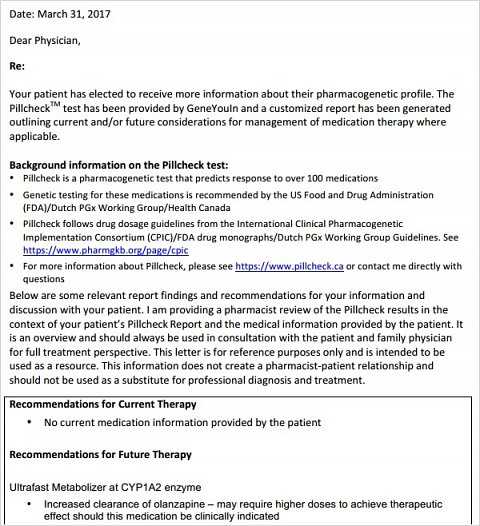
My Pharmacist Opinion letter.
This letter was separate to my report, and was personalised with my name (removed from the screenshot). It was addressed to my doctor and included both an explanation of the test and recommendations. I really appreciated that this explanation was included, as it meant that I wouldn’t have to try and the test myself. I also felt that my doctor was more likely to take the results seriously, as it not only explained the test, but mentioned that it was recommended by several health organisations.
The recommendations were similar to those included to the ones in my report, but slightly more technical and it was signed at the bottom by a pharmacist. As well as the signature, the pharmacist’s name and credentials was listed, including his registration number. I was glad that this was included as I felt it would further convince my doctor of the legitimacy of the report, and meant I was able to carry out further research to make sure that it was a genuine pharmacist.
Summary
In summary, I’m really glad I took the Pillcheck test. I was particularly impressed that it was so useful to someone not currently taking any medications and felt that it would be a really useful tool for my doctor when prescribing anything in the future.
I did find that some phrases were a little complex and made parts of the report a little difficult to understand. This said, I was clearly able to see which of the medications I should be wary about using, which was the main thing I expected to get from the results, and the rest will hopefully be useful to my doctor.
I’d recommend this test even to those that don’t take any current medications. It was interesting to read, and I felt that it was likely to be a valuable tool for helping me stay as healthy as possible, both now and in the future.

